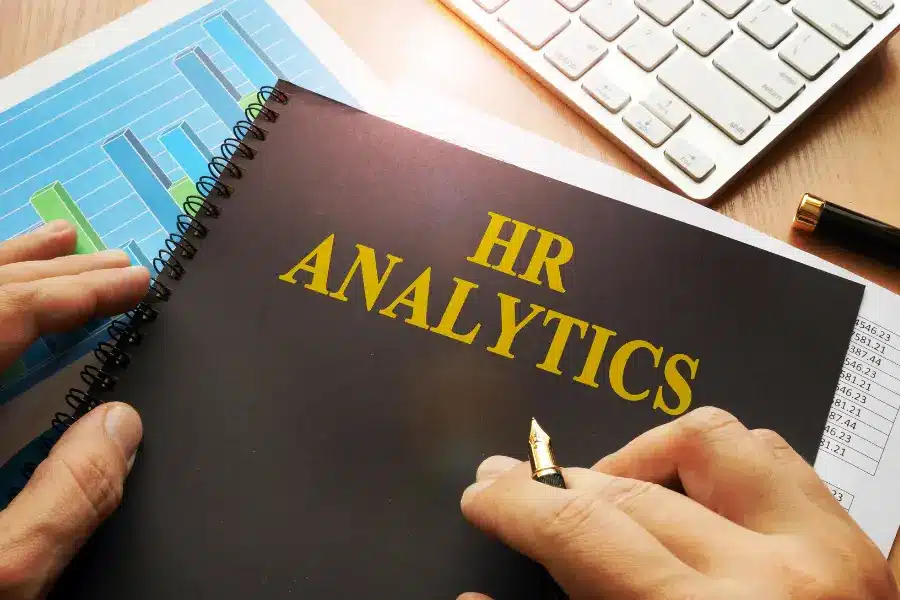Human resources analytics is a clever phrase for analyzing the application of data and technology in human resources. It is not just finding the right software and plugging it into your HR department, but also requires a great deal of thinking.
When we think of HR analytics, we normally envision a report that represents some piece of business value. However, one of the core purposes is to enable HR leaders to be more data-driven. For this reason, it’s no surprise that most HR professionals are looking for answers and insights from the data. We’ve compiled a definition of HR Analytics and How it works.
HR Analytics: What Are They?
The practice of gathering and analyzing Human Resource (HR) data in order to enhance an organization’s workforce performance is known as HR analytics. The procedure may also be known as workforce analytics, talent analytics, or even people analytics.
By using this technique, HR routinely collects data and compares it with organizational goals to see if improvements are needed. If you can show how the HR department is advancing the company’s goals, it will be more likely to get funding.
If a software engineering firm has a high personnel turnover rate, the organization is not fully productive level. Analytics can give companies the data they need to make adjustments and plan for the future.
How do HR Analytics work properly?
HR analytics is the process of collecting, analyzing, and reporting data to identify trends and patterns that can inform HR practices.
HR analytics can be used to help improve employee retention, engagement, and productivity. It can also help identify potential problems in your workforce, such as discrimination or sexual harassment.
Recognizing the HR Analytics process
- Analytics encompasses a variety of components.
- To obtain insights about the problems that affect your company, you’ll first need to gather data.
- After the data has been collected, you must study and analyze it to see how it compares with other sets of data.
- Analyzing results at this level allows you to spot trends or patterns.
- Using insight to help make decisions is the last stage of organizational development.
Why do we require HR Analytics?
Why would most firms need a specific type of analytics when they already have data that is regularly collected? They should be able to use the data they have in their HR departments.
Raw data, although important in its own right, is not enough to draw meaningful conclusions from. The data is meaningless in the absence of structure and direction. Comparison and analysis of this unorganized data yield valuable information. For Example, Does employee performance improvement based on the initiatives for learning and development?
When organizations have data-backed evidence, they can concentrate on making the required adjustments and planning for future efforts.
HR Analytics: Benefits and Drawbacks
HR practices are quickly adopting analytics as a desired feature. Without aggregation and analysis, data gathered throughout the organization is worthless. Thus, HR analytics provides quantifiable insight that previously did not exist.
While HR analytics has the potential to elevate HR practice from a tactical to a strategic level, it is not without difficulties. Here are some of the pros and cons of using HR analytics:
Pros
- Making decisions based on data allows organizations to make decisions more accurately since intuition and guesswork are eliminated.
- A greater comprehension of what causes employees to leave or remain with an organization can be used to design strategies that will increase retention.
- By examining data on employee behavior, such as their interactions with coworkers and customers, and figuring out how processes and the environment can be improved, employee engagement may be increased.
- By examining and comparing the data of present employees, potential applicants can be more accurately targeted to an organization’s actual skill needs.
- Predictive analytics can forecast patterns in HR data, allowing companies to be proactive and keep their workforce productive.
Cons
- Many HR departments lack the statistical and analytical know-how necessary to handle huge datasets.
- It is difficult to aggregate and compare data across the business due to various management and reporting systems.
- Data quality is often a problem for companies still using older computer systems.
- Analytical and reporting software is necessary for any organization that collects large amounts of data.
- Collecting more data and using new technology, such as wearables, to gather that information presents ethical concerns.
Final Words
HR Analytics is a tool that businesses can use to manage and improve the performance of their workforce. Using data from the business, managers can see where they could make improvements and what’s going well. Results go beyond simply identifying problems and can help create new goals in line with corporate needs. It’s creating a win-win situation for the business and its employees.



![10 Best Bags for Nurses | Personal Recommendation [2023] 4 Best Bags For Nurses Reviews in 2021](https://knowworldnow.com/wp-content/uploads/2022/12/Best-Bags-For-Nurses-Reviews-in-2021.webp)



![F95Zone Games - The Ultimate Guide for 2021 [F95Z Guide] 8 F95Zone Games](https://knowworldnow.com/wp-content/uploads/2021/07/ArTtW5LrK3b-z-0-y-637f48d86203817a9042a857.webp)